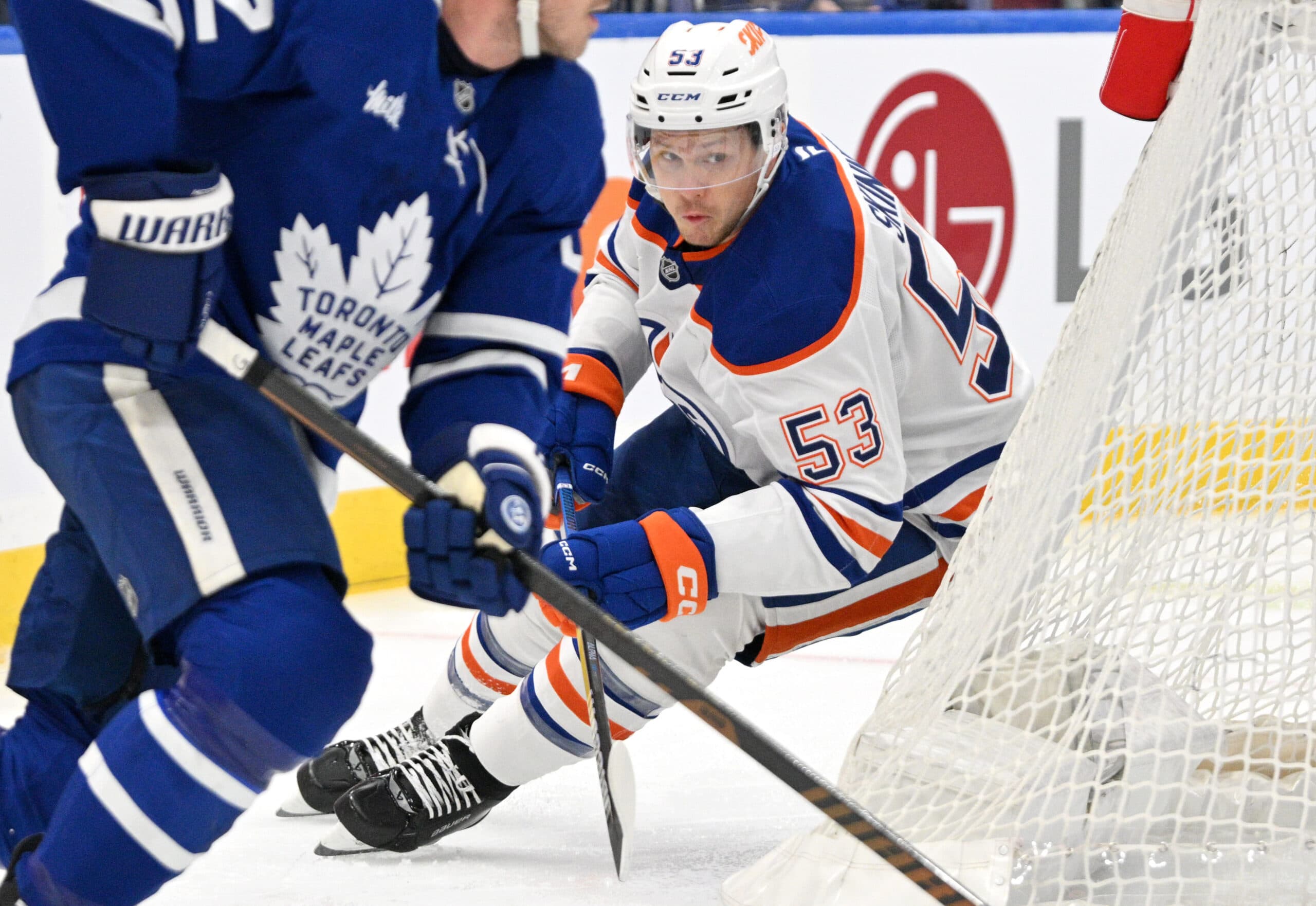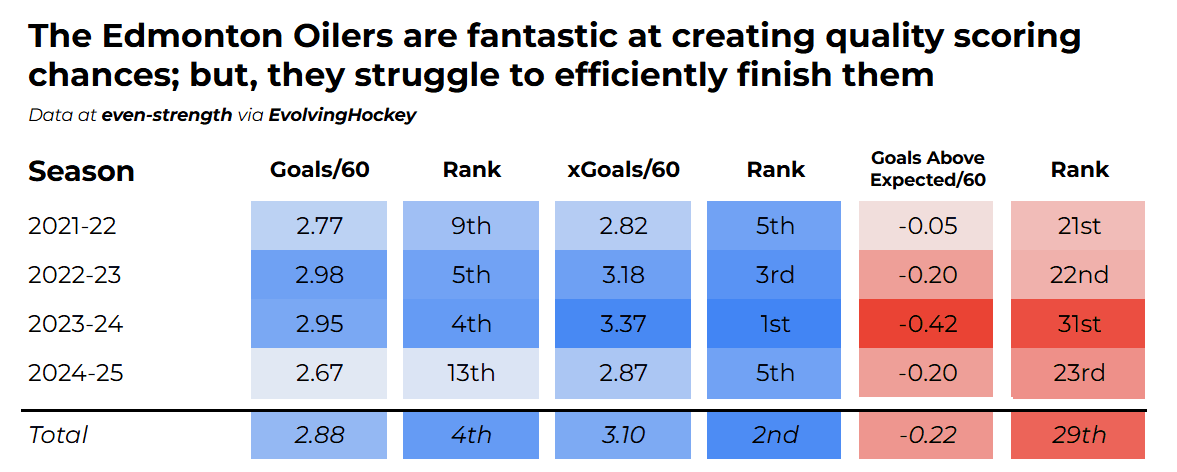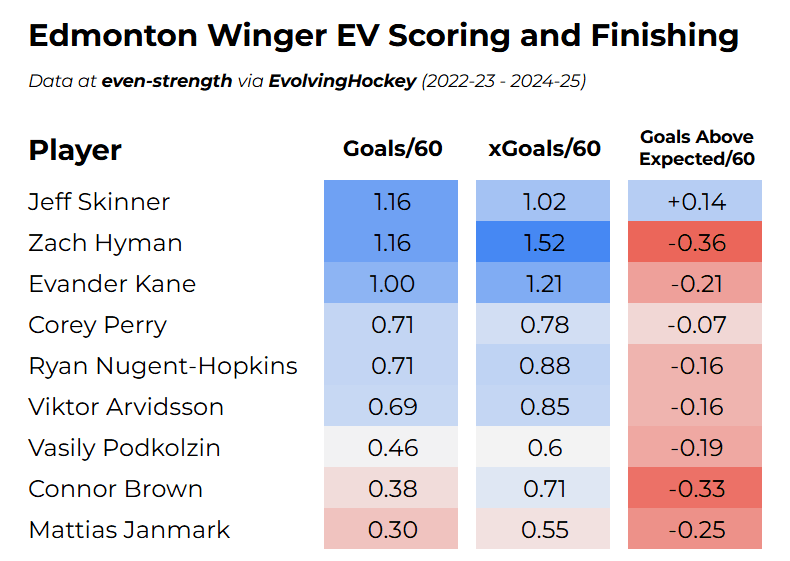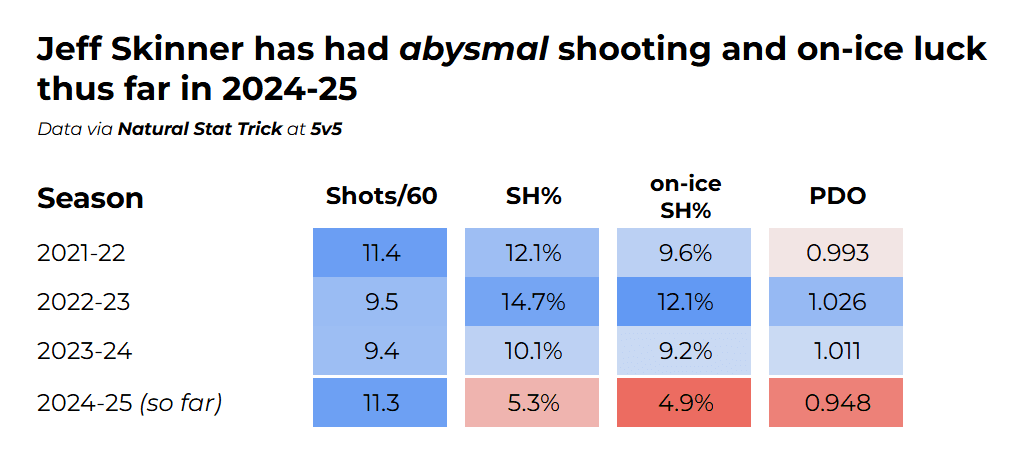Nation Sites
The Nation Network
OilersNation has no direct affiliation to the Edmonton Oilers, Oilers Entertainment Group, NHL, or NHLPA
Despite his slow start, Jeff Skinner still has the potential to be a valuable player for the Oilers

Photo credit: Dan Hamilton-Imagn Images
This past summer, the Edmonton Oilers certainly had one of their most eventful free agency days in recent history. On July 1st, Jeff Jackson made a handful of various signings, highlighted by two new additions: Jeff Skinner and Viktor Arvidsson. With both of them projected as top-six wingers next to Connor McDavid and Leon Draisaitl, there was quite a lot of confidence about Edmonton’s forward group heading into the season.
Unfortunately, neither of those signings have yet to bear fruit for the team.
The biggest risk with Arvidsson was his injury history, and that has been on display this season. When Arvidsson missed practice on November 13, head coach Kris Knoblauch simply called it a maintenance day, stating it would be a 50/50 chance he would play the next day; that was over two weeks ago. Arvidsson remains out of the lineup, and is still not expected to play in Edmonton’s next two games.
As for Jeff Skinner, he initially had a great start to the season, arguably being their most consistent player in the first week. But ever since, Skinner has seemed to be in Knoblauch’s doghouse, as despite the fact that two of Edmonton’s top-six wingers — Viktor Arvidsson and Zach Hyman — have missed several games to injury, Skinner has primarily played on the third or fourth line throughout the past month.
So far, Skinner’s on-ice results at 5-on-5 are far from pretty. His 48 percent expected goal differential ranks 10th among the team’s forwards, while his 32 percent actual goal differential ranks dead last, as the Oilers have been out-scored at a rate of 8 to 17 with Skinner on-ice. He’s not deployed on any of Edmonton’s special teams either.
Skinner’s early season struggles have caused several fans to question this signing in the first place. It is evident that even Edmonton’s own coaches are not a huge fan of him, potentially due to his lackluster defensive game or ineffective forechecking.
But, despite all of this, I believe Jeff Skinner still has the potential to be a very useful player for the Oilers.
Skinner can provide one key element that nearly every other Edmonton winger severely lacks: finishing talent. Let me explain why.
Now, there has been plenty of talk about Edmonton’s defence and goaltending, and rightfully so. After all, they rank 19th in the league in goals allowed per hour, which is inadequate for a cup contender.
However, the Oilers also rank 17th in the league in total goals per hour, and 18th in 5v5 goals. Their scoring rates are also far from satisfactory for this team, and I don’t see this being mentioned nearly enough.
Goal prevention can be split into two aspects: shot suppression, which is how well the skaters can limit shots / scoring chances against, and goaltending, which is how well the goalies can stop the shots that do get through. Similarly, we can also split goal scoring into two aspects: shot generation, which is how well the team can create shots / chances, and finishing, which is how well the team can score on the shots they create.
Throughout the past few years, the Oilers have been one of the best teams in the league at generating shots and quality scoring chances by a pretty solid margin. But finishing? Not so much.

In the past four seasons combined, the Oilers rank 2nd in expected goals per hour, but 29th in goals scored above expected. Of course, they still rank 4th in overall goals, but the point is that, relative to how many chances the team is creating, they are still leaving a lot of offence on the table.
To showcase why, consider that the Oilers ranked sixth in the league in goal differential in 2023-24, sitting at +56. If they simply had league average finishing at 5-on-5, they would have scored roughly ~30-31 (!!) goals more.
This would have propelled them all the way to the top of the league in goal differential by a solid margin. At that point, first place in the Pacific Division would have been a lock for them.
It’s certainly worth mentioning that in the 2024 Stanley Cup Finals, the Florida Panthers had home-ice advantage. The Oilers went 2-1 at home in Rogers Place, but 1-3 at Amerant Bank Arena in Florida. Could the Oilers have had a different outcome if they possessed home-ice? We’ll never know, but it’s not far-fetched to believe that at the very least, it would have increased their chances of winning it all.
Speaking of the 2024 cup finals, the Oilers accumulated a total of 7.4 expected goals in Games 1, 2 and 7 of the finals. And yet, they scored a mere 2 goals on Bobrovsky in those three games, ultimately losing all three. Their Game 7 loss was only by a single goal.
If the Oilers had just one more finishing winger? This story could have been a lot different.
Yes, the Oilers need a defenceman and likely another goaltender. But, finishing is also a significant area of improvement for this team, particularly at 5v5. Led by Connor McDavid and Leon Draisaitl, they have plenty of players that can create quality chances, but not nearly enough that can efficiently finish them outside of their elite superstars.
Their finishing struggles primarily originate from their wingers. When fully healthy, the team’s nine best wingers are (in no order): Connor Brown, Corey Perry, Evander Kane, Jeff Skinner, Mattias Janmark, Ryan Nugent-Hopkins (I consider him a LW at this stage of his career), Vasily Podkolzin, Viktor Arvidsson and Zach Hyman.
Among these nine players, there is only one that has scored more goals than expected in the past three seasons at even strength: Jeff Skinner.

I often like to split goal-scorers into two categories: volume scorers and finishers. Volume scorers are players that score a high number of goals because they generate a high volume of shots and chances, with Zach Hyman and Evander Kane being great examples. On the other hand, finishers are players that may not necessarily generate a lot of shots/chances, but they efficiently capitalize on the ones they do. A well-rounded team should have a good mix of both.
Based on the past three seasons of play, the only Oilers forward not named Leon Draisaitl or Connor McDavid that fits the criteria of a “finisher” is Jeff Skinner.
This is why I highly supported the Skinner signing at the time. Signing him at three million for one year is a perfectly fine bet to make, and even with the benefit of hindsight, I would make this signing again.
Yes, there are some critical flaws in Skinner’s game. His underlying defensive numbers in both Buffalo and Edmonton (so far) have been quite poor, he’s a subpar forechecker, and not the best puck-carrier.
But, this is precisely why Skinner only makes three million. He was not signed to be some defensively-minded two-way winger in the first place. Skinner was signed because his finishing talent addresses a key area of improvement for this team.
Of course, one may immediately retort that Skinner has not been a great goal-scorer for the Oilers this season in the first place. He has four goals in 24 games – nothing spectacular. At age 32, there are some concerns regarding if his decrease in scoring from prior seasons is simply age decline.
But, I think there are some external reasons for his struggles in Edmonton that must be noted.
Firstly, Skinner has had some pretty awful puck luck.

A common proxy used to assess puck luck is PDO, which is the sum of a player’s on-ice shooting percentage and save percentage. The vast majority of players will have an average PDO of about ~1.00. A PDO above ~1.02-1.03 typically means the player has had exceptional puck luck and the results are unsustainable, while a PDO below ~0.99-0.98 means the player has been very unlucky. Jeff Skinner’s career average PDO is roughly ~0.996.
However, his PDO in 2024-25 is a mere 0.948.
Skinner’s -9 rating in 24 games may look ugly, but poor puck luck is the primary reason for that. He possesses an incredibly low on-ice shooting percentage of 4.9%, which is at even lower 1.92% in the past 10 games.
I feel that lot of people tend to underestimate the impact that puck luck can have on a player’s results at the beginning of a season. History strongly suggests that as the season progresses and the sample increases, Skinner’s goal differential will significantly improve.
The encouraging thing is that Skinner is still shooting pucks at a high rate. In fact, his 5v5 shots per hour is higher than it was in each of the past two seasons. The decrease in his goal-scoring can be attributed to the fact that his shooting percentage has nearly halved.
Skinner may be 32, but no player’s shooting talent is going to drop that drastically in a single season, especially moving from a perennial lottery team to a cup contender. A SH% of 5% is very, very unlikely to sustain considering his track record.
Secondly, I feel that deployment has a lot to do with Skinner’s struggles.
All things considered, I believe Kris Knoblauch is a fine coach. But, like many Oiler coaches before him, I feel that he alters the forward lines far too frequently, and this has especially been the case with Skinner this season.
Skinner has yet to play more than four straight games on the same line, and has been shuffled throughout all four lines at various points this season. Three of Skinner’s four most common linemates have been defencemen.
Currently, Skinner is on the third line with Adam Henrique and Mattias Janmark, and was on the fourth line prior to that. Simply put, I don’t think this is doing Skinner any favours.
It’s not allowing him to create chemistry with his linemates, and is not putting him in a place to truly succeed and showcase his strengths. I feel that Knoblauch is trying to turn Skinner into a player he’s not.
At this stage of his career, Skinner is simply a skilled, shoot-first finishing winger; nothing more, nothing less. For a team that struggles to consistently capitalize on their chances, this is the exact type of forward that Edmonton could heavily benefit from, if used correctly. Historically, Skinner has performed best next to skilled centers, which is why deploying him in the bottom-six before granting him an extended look next to McDavid or Draisaitl is a waste of his talents.
Even with everything in mind, in spite of both his awful puck luck and unideal deployment, it must be mentioned that Skinner still remains tied for fourth among the team’s forwards in 5v5 goals. Skinner has more 5v5 goals than Ryan Nugent-Hopkins, Zach Hyman, and Viktor Arvidsson, all while spending substantially less time next to McDavid and Draisaitl.
The current results may not be pretty, but there’s still a player there.
This season, Vasily Podkolzin has proven to be a very useful complementary player for Leon Draisaitl in the top-six, with tenacious forechecking and reliable defensive play. Many of his strengths complement Skinner’s weaknesses, and considering that Podkolzin played significant time at RW in Vancouver, I wonder about a second-line of Skinner – Draisaitl – Podkolzin. In theory, they stylistically pair well. Additionally, throughout the past four seasons, Connor McDavid and Zach Hyman have produced excellent results regardless of who is on their left-wing, so there may be an spot for Skinner there as well.
Either way, moving forward, I would like to see Jeff Skinner obtain an extended period of time in the top-six at some point this season. There is a very solid chance that it will pay off for the Oilers.
Find me on Twitter (@NHL_Sid)
Breaking News
- Zach Hyman’s hat trick launches Oilers over Red Wings: Recap, Highlights, Reaction
- Real Life Podcast: Philip Rivers’ NFL return, music vs. pop culture, and Jay’s traffic tickets
- Oilers recall Max Jones, place Jake Walman on Long-Term Injured Reserve
- GDB 31.0: An Oilers Win Makes it a Very Successful Homestand (7 PM, SNW)
- Scenes From Morning Skate: Oilers can’t let another opponent on second-half of back-to-back win
